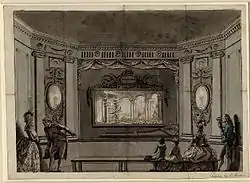Eidophusikon
The Eidophusikon (Greek: Ειδωφυσικον) was a piece of art, no longer extant, thought up by the English actor David Garrick and created by 18th-century French painter Philip James de Loutherbourg. It opened in Leicester Square in February 1781.

Described by the media of his day as "Moving Pictures, representing Phenomena of Nature", the Eidophusikon can be considered an early form of movie making. The effect was achieved by mirrors and pulleys.
A small exhibition centered on his Eidophusikon can currently be seen at The Huntington Library.
A full Eidophusikon, described also as a "small, mechanical theatre", was exhibited from June to November 2014 at the exhibition "Underworlds" (Unterwelten) in Dortmund, Germany.
The Eidophusikon consisted of a large-scale miniature theatre that let experiment the try of creating the perfect illusion of the moving nature: sunrise scenes, sunsets, moonlight images, storms, and volcanoes from all over the world with sound and music effects. The sound and light effects of the Eidophusikon, compared with the shows seen until that time, were specially inventive by their realism.
Reconstructions
The first reconstruction was the year 2004 by Wolkenbilder at the Altonaer Museum Exhibition (cloud images) at Jenisch Has, Hamburg. It was a full-sized theater with two scenes on the basis of Loutherbourg: from dawn to sunset over Royal Naval College in Greenwich and a Mediterranean scene with a lighthouse, moonlight, storms and wrecks.
The second Eidophusikon was created in 2005 by the Yale Center for British Art, New Connecticut and California Huntington Library by the English painter Gainsborough for his collection 'Sensation and sensibility. Gainsborough was a great admirer of Eidophusikon. This full-size version was built in conjunction with Kevin Derkin and the Yale technical department under Rick Johnson. The scene, this time, was 'Satan and the Creation of the Pandemonium Palace in Hell', by Milton of the "lost paradise."
In 2006, a third Eidophusikon was created by Robert Poulter for the Nouveau Musée National de Monaco. Another Mediterranean scene was created with a volcano, the moonlight, the storm and the shipwreck. This Eidophusikon is part and the permanent collection of the museum.
See also
References
External links
- Sensibility and the Cult of Special Effects (dead link)
- Modern recreation of an Eidophusikon (dead link)
- An Eighteenth-Century Movie Show. Centre for Cross-Cultural Research, Australian National University, Canberra, 2006. 3D digital recreation of an eidophusikon demonstration and
- Active German Eidophusikon in Dortmund, Germany (June--October 2014) (German text)
- Video of German active Eidophusikon in Dortmund, Germany
- Robert Poulter's New Model Theatre
